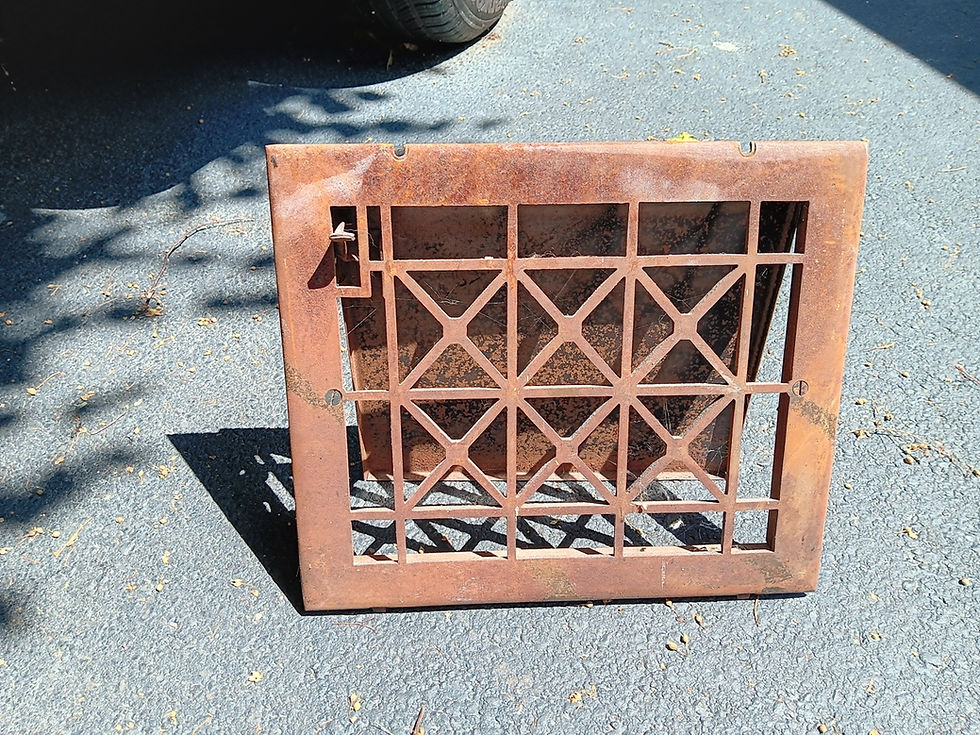Ideas from Ed: What the hex? (Volume 7 issue 2)
- edwardpetrus

- Mar 31, 2024
- 4 min read
I doubt if any of you will need to do exactly what I did this month, but this was a fast and fun project that “just needed doing.” I’m using it as one of my “Ideas” columns just to show you that with a little bit of thinking and a few tools you might be able to tackle that one “annoying task” that really can be completed rather easily.
My wife acquired this nice glass drink container at a local auction.


It’s roughly hexagonal, and has a nice drip-free spout. However, like similar dispensers that we own, there’s a small problem. It has to be placed right at the edge of a table so that a cup can be placed under the spout. That may not seem like a big deal, but it’s annoying, and makes it so much more likely to be knocked off. My wife asked me to make some kind of a stand so that it can be placed anywhere on a table, essentially raising it high enough to give cup clearance. I thought it would be neat to do more than just make a square block of wood, and wanted to mimic the hexagonal shape.
I traced the outside edges on a sheet of paper. I determined that the container would fit neatly inside of a circle that had a diameter of 8 ½ inches.

Remember all that high school geometry? A circle with a diameter of 8 ½ inches has a radius (half the diameter) of 4 ¼ inches. I set a compass to 4 ¼ inches and drew such a circle. Then, without making any change to the compass, I marked around the circle, drawing 6 small arcs. (The length of a radius perfectly divides the circumference into six lengths.)

Connecting those drawn marks draws a precise hex shape. I test fit the glass dispenser into the drawing to be sure of things.


I drew across the hexagon’s “points” so that it’s clearer to see the angles involved.

I guess you’ll have to trust me on this if you’ve forgotten the geometry lessons, but if I made “sides” with bevels on each edge, the cut would need to be 30 degrees from a perpendicular one (each, times 2, equals 60 degrees, times 6 for the hex, equals 360 degrees of a circle…) Here’s a drawing showing what I mean. I also measured the inside length of a side at 4 ¼ inches.

I bought a piece of nice clear (knot-free) 1x6 pine. If a hex-shaped box was 5 inches high, with a shelf inside it placed roughly an inch down from the top, the spout would be high enough that a 5 inch cup would fit under it. (Remember, the spout is already a bit off the bottom of the container -- in this case about 1 ½ inches.)
I cut the 1x6 into 5 inch lengths. I wanted the end grain to be in the up-and-down direction, leaving the bevels to be cut in the direction where glue would make the joints strongest. I cut the needed 30 degree bevel on one side of each piece, and then moved the fence (trial and error) until the inside edge measured 4 ¼ inches when I cut the opposite side bevel.

Working on a flat surface (floor, in my case) I carefully placed all of the pieces bevel-to-bevel, with the bevels down. I used pieces of painter’s tape to link all of the sections tightly together.

I gently flipped the whole array over, which allowed me to brush wood glue into each joint. I don’t endorse any particular product in my columns, but this is the glue that I typically use for woodworking projects like this.


The whole thing was then “rolled up” and the end-to-end joint taped to hold things together while the glue dried. If the cuts were accurate, and care taken when taping the joints, it should all fit well together (and it did!)

Once the glue dried I pulled off all the tape, and traced the inside of the shape onto another board, which would become the shelf of the finished unit.

I cut the shelf on my bandsaw, just shy of the lines, and then sanded “to the line” for a good fit.

Since I wanted this to be “nice” but it’s not a fine piece of furniture, I took the easy way out of attaching the shelf, using 18-gauge pins and an air nailer. Then I filled the nail holes and imperfections in the fittings using a sandable wood filler. A nicer way of doing things would have been to attach cleats to the inside of the hex, allowing the shelf to rest on them without using any nails through the sides. Doing it my way is a lot stronger since the shelf is attached to all of the sides. (Remember, that glass jug full of drinks is heavy!)

I sanded everything by hand, and rounded over all the sharp edges for a more appealing look. Here’s how it all fit together. With a bit of wood stain, and possibly a coat of polyurethane for protection, I think this should last (and function) for a long time!

I hope all your projects go well. Thanks for reading, and happy restoring!
Ed
If you’d like to download a PDF of this “Ideas” column, click here:




Comments